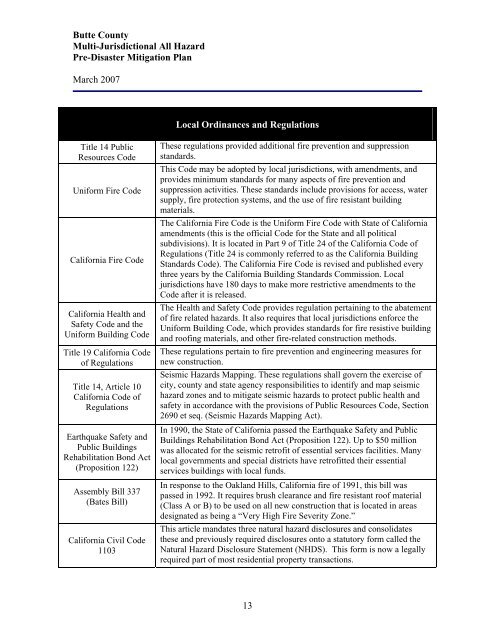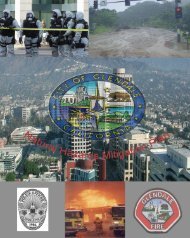Butte County MHMP - State of California
Butte County MHMP - State of California
Butte County MHMP - State of California
Create successful ePaper yourself
Turn your PDF publications into a flip-book with our unique Google optimized e-Paper software.
<strong>Butte</strong> <strong>County</strong>Multi-Jurisdictional All HazardPre-Disaster Mitigation PlanMarch 2007Local Ordinances and RegulationsTitle 14 PublicResources CodeUniform Fire Code<strong>California</strong> Fire Code<strong>California</strong> Health andSafety Code and theUniform Building CodeTitle 19 <strong>California</strong> Code<strong>of</strong> RegulationsTitle 14, Article 10<strong>California</strong> Code <strong>of</strong>RegulationsEarthquake Safety andPublic BuildingsRehabilitation Bond Act(Proposition 122)Assembly Bill 337(Bates Bill)<strong>California</strong> Civil Code1103These regulations provided additional fire prevention and suppressionstandards.This Code may be adopted by local jurisdictions, with amendments, andprovides minimum standards for many aspects <strong>of</strong> fire prevention andsuppression activities. These standards include provisions for access, watersupply, fire protection systems, and the use <strong>of</strong> fire resistant buildingmaterials.The <strong>California</strong> Fire Code is the Uniform Fire Code with <strong>State</strong> <strong>of</strong> <strong>California</strong>amendments (this is the <strong>of</strong>ficial Code for the <strong>State</strong> and all politicalsubdivisions). It is located in Part 9 <strong>of</strong> Title 24 <strong>of</strong> the <strong>California</strong> Code <strong>of</strong>Regulations (Title 24 is commonly referred to as the <strong>California</strong> BuildingStandards Code). The <strong>California</strong> Fire Code is revised and published everythree years by the <strong>California</strong> Building Standards Commission. Localjurisdictions have 180 days to make more restrictive amendments to theCode after it is released.The Health and Safety Code provides regulation pertaining to the abatement<strong>of</strong> fire related hazards. It also requires that local jurisdictions enforce theUniform Building Code, which provides standards for fire resistive buildingand ro<strong>of</strong>ing materials, and other fire-related construction methods.These regulations pertain to fire prevention and engineering measures fornew construction.Seismic Hazards Mapping. These regulations shall govern the exercise <strong>of</strong>city, county and state agency responsibilities to identify and map seismichazard zones and to mitigate seismic hazards to protect public health andsafety in accordance with the provisions <strong>of</strong> Public Resources Code, Section2690 et seq. (Seismic Hazards Mapping Act).In 1990, the <strong>State</strong> <strong>of</strong> <strong>California</strong> passed the Earthquake Safety and PublicBuildings Rehabilitation Bond Act (Proposition 122). Up to $50 millionwas allocated for the seismic retr<strong>of</strong>it <strong>of</strong> essential services facilities. Manylocal governments and special districts have retr<strong>of</strong>itted their essentialservices buildings with local funds.In response to the Oakland Hills, <strong>California</strong> fire <strong>of</strong> 1991, this bill waspassed in 1992. It requires brush clearance and fire resistant ro<strong>of</strong> material(Class A or B) to be used on all new construction that is located in areasdesignated as being a “Very High Fire Severity Zone.”This article mandates three natural hazard disclosures and consolidatesthese and previously required disclosures onto a statutory form called theNatural Hazard Disclosure <strong>State</strong>ment (NHDS). This form is now a legallyrequired part <strong>of</strong> most residential property transactions.13

















